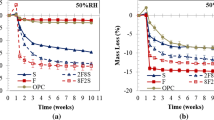Abstract
This paper describes the results of an investigation into the effect of the variation of curing temperatures between 0 and 60 °C on the hydration process, pore structure variation, and compressive strength development of activated coal gangue-cement blend (ACGC). Hardened ACGC pastes cured for hydration periods from 1 to 360 d were examined using the non-evaporable water method, thermal analysis, mercury intrusion porosimetry, and mechanical testing. To evaluate the specific effect of activated coal gangue (ACG) as a supplementary cementing material (SCM), a fly ash-cement blend (FAC) was used as a control. Results show that raising the curing temperature accelerates pozzolanic reactions involving the SCMs, increasing the degree of hydration of the cement blends, and hence increasing the rate of improvement in strength. The effect of curing temperature on FAC is greater than that on ACGC. The pore structure of the hardened cement paste is improved by increasing the curing temperature up to 40 °C, but when the curing temperature reaches 60 °C, the changing nature of the pore structure leads to a decrease in strength. The correlation between compressive strength and the degree of hydration and porosity is linear in nature.
Similar content being viewed by others
References
Escalante-garcía, J.I., Sharp, J.H., 2001. The microstructure and mechanical properties of blended cements hydrated at various temperatures. Cement and Concrete Research, 31(5):695–702. [doi:10.1016/S0008-8846(01)00471-9]
Gómez-Zamorano, L.Y., Escalante-García, J.I., 2010. Effect of curing temperature on the nonevaporable water in Portland cement blended with geothermal silica waste. Cement and Concrete Composites, 32(8):603–610. [doi:10.1016/j. cemconcomp.2010.07.004]
Gong, C.C., Song, X.Y., Li, D.X., 2005a. Mechanism discussion on calcined activate coal gangue. Journal of Material Science and Engineering, 23(1):88–91, 108 (in Chinese).
Gong, C.C., Tao, X., Li, D.X., 2005b. Study on activation and structure performance of calcined coal gangue. Material Review, 19(2):115–117, 120 (in Chinese).
Haneharas, S., Tomosawa, F., Kobayakawa, M., Hwang, K.R., 2001. Effects of water/powder ratio, mixing ratio of fly ash, and curing temperature on pozzolanic reaction of fly ash in cement paste. Cement and Concrete Research, 31(1):31–39. [doi:10.1016/S0008-8846(00)00441-5]
Hu, S.G., Wang, X., Lü, L.N., Geng, J., Ding, Q.J., 2005. The influence of coal gangue to the hydration process of Portland coal gangue cement. Cement, (8):5–7 (in Chinese).
Leng, F.G., 2000. The comprehensive utilization of coal slack. Build Science Research of Sichuan, 26(2):44–46 (in Chinese).
Li, D.X., Song, X.Y., Gong, C.C., Pan, Z.H., 2006. Research on cementitious behavior and mechanism of pozzolanic cement with coal gangue. Cement and Concrete Research, 36(9):1752–1759. [doi:10.1016/j.cemconres.2004.11.004]
Liu, X.P., Wang, P.M., 2008. Interface structure of Portland coal gangue blended cement. Journal of the Chinese Ceramic Society, 36(1):104–111 (in Chinese).
Liu, X.P., Wang, P.M., Xia, C.H., 2006. Study on Morphologies of Hydrates of High C3S Content Cement Mixed with Coal Gangue at Various Temperatures. 6th International Symposium on Cement and Concrete/Canmet-ACI International Symposium on Concrete Technology for Sustainable, Xi’an, China. Foreign Language Press, Beijing, China, p.242–248.
Lothenbach, B., Winnefeld, F., Alder, C., Wieland, E., Lunk, P., 2007. Effect of temperature on the pore solution, microstructure and hydration products of Portland cement pastes. Cement and Concrete Research, 37(4):483–491. [doi:10.1016/j.cemconcres.2006.11.016]
Lothenbach, B., Matschei, T., Möschner, G., Glasser, F.P., 2008. Thermodynamic modelling of the effect of temperature on the hydration and porosity of Portland cement. Cement and Concrete Research, 38(1):1–18. [doi:10.1016/j.cemconcres.2007.08.017]
Matschei, T., Glasser, F.P., 2010. Temperature dependence, 0 to 40 °C, of the mineralogy of Portland cement paste in the presence of calcium carbonate. Cement and Concrete Research, 40(5):763–777. [doi:10.1016/j.cemconcres. 2009.11.010]
Mehta, P.K., Monteiro, P.J.M., 1993. Concrete: Structure, Properties and Materials. Prentice Hall, New Jersey, USA, p.22–36.
Rojas, M.F., Sánchez de Rojas, M.I., 2005. Influence of metastable hydrated phases on the pore size distribution and degree of hydration of MK-blended cements cured at 60 °C. Cement and Concrete Research, 35(7):1292–1298. [doi:10.1016/j. cemconcres.2004.10.038]
Taylor, H.F.W., 1997. Cement Chemistry. Thomas Telford Publishing, London, England, p.238–252.
Wang, P.M., Liu, X.P., Hu, S.G., Lü, L.N., Ma, B.G., 2007. Hydration models of Portland coal gangue cement and Portland fly ash cement. Journal of the Chinese Ceramic Society, 35(S1):180–186 (in Chinese).
Zhang, J.X., Sun, H.H., Sun, Y.M., Zhang, N., 2010. Corrosion behavior of steel rebar in coal gangue-based mortars. Journal of Zhejiang University-SCIENCE A (Applied Physics and Engineering), 11(5):382–388. [doi:10.1631/jzus.A0900443]
Author information
Authors and Affiliations
Corresponding author
Additional information
Project supported by the National Basic Research Program of China (Nos. 2001CB610704 and 2009CB623104), and the Youth Foundation of Key Laboratory of Advanced Civil Engineering Materials (Tongji University), Ministry of Education, China
Rights and permissions
About this article
Cite this article
Wang, Pm., Liu, Xp. Effect of temperature on the hydration process and strength development in blends of Portland cement and activated coal gangue or fly ash. J. Zhejiang Univ. Sci. A 12, 162–170 (2011). https://doi.org/10.1631/jzus.A1000385
Received:
Accepted:
Published:
Issue Date:
DOI: https://doi.org/10.1631/jzus.A1000385




